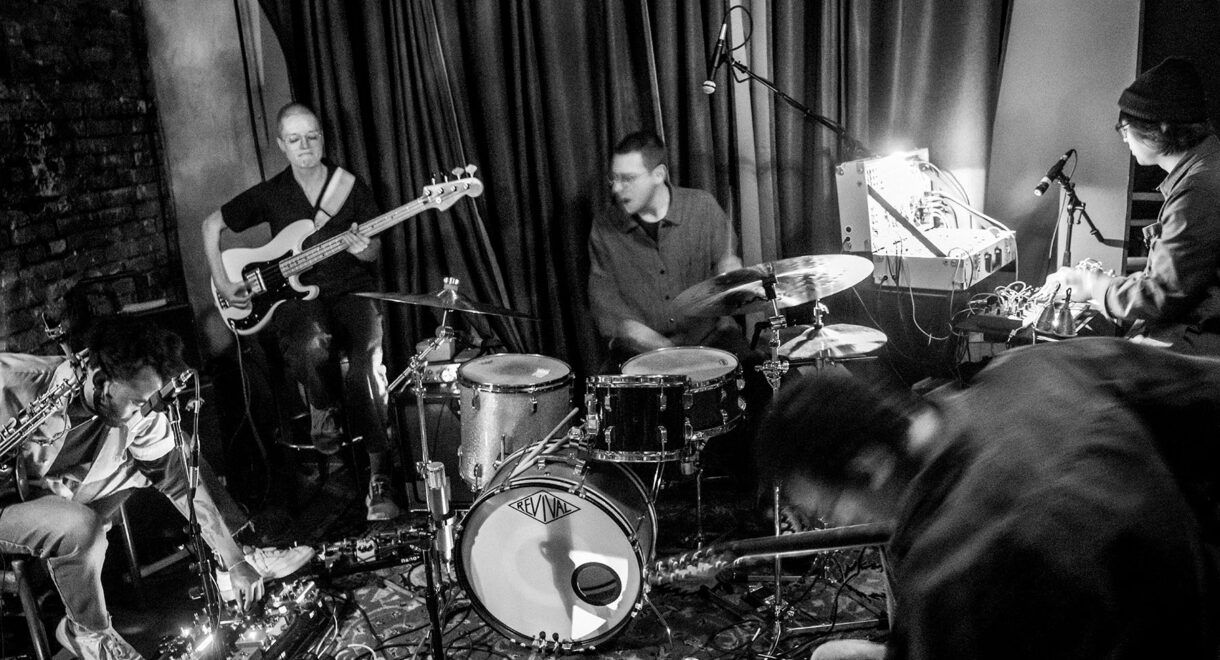Let’s talk about Roberto Musci, the Milanese experimental composer whose work both alone and with kindred spirit Giovanni Venosta starting in the 1980s has been gaining attention and […]
El Marchante: Experimental Sounds of Latin America

A sonic trip through Latin America with selections by El Marchante’s Osmar Romero.
Last Friday on Cinco de Mayo, we presented a special listening session at the Japanese American Cultural & Community Center in Little Tokyo. Dedicated to Latin experimental sounds, the event was co-presented by Osmar Romero of El Marchante and Del Caribe, a local producer, DJ, and collector. For those unfamiliar, El Marchante is a project that aims to compile, research and disseminate music made in Latin America. They currently operate a record store in Caracas, Venezuela, an online shop, and also pop up at record events across Los Angeles including our bi-monthly record fair at Homage Brewing.
You can visit their website here: https://www.elmarchante.org/
Check out their monthly event series Mosaico, a night dedicated to Latin American and Caribbean music, at The Goldfish in Highland Park.
Below, we’ve included selections from the listening session including a brief introduction from Osmar. For further reading and listening, we also highly recommend checking out the Fusion and Experimental Music in Latin America feature on El Marchante’s blog.
From Osmar: “Although the concept of experimental music is quite broad and perhaps ambiguous, we decided to choose that frame to talk about Latin American musicians who pushed the limits of the established music at the time, either by introducing new technologies, or subverting and mixing different musical styles.
We will tour Latin America from North to South, dividing this trip in 3 sections. The first takes us to Mexico and Central America; the second, to Puerto Rico, Cuba, Colombia, and Venezuela: the third one, to Brazil, Peru, Uruguay and Argentina. This tour is not intended to be an exhaustive or definitive guide, but rather, a starting point into a compelling and diverse territory.”
Eblen Macari – La Constelacion Del Pejelagarto (Mexico, 1987)
This track is from the album Música para Planetarios which was made to be played during shows at a planetarium in Mexico City.
Esquivel And His Orchestra – Latin-Esque (Mexico, 1962)
This album from Mexican-American musician Juan García Esquivel was part of the “Stereo Action” series, which aimed to push the stereo concept to its limits by recording the orchestra in real time, divided into two rooms, and recreating the sound on two different channels. This innovative approach was revolutionary for its time and marked a turning point in music as we know it today.
Luis Enríque Mejía Godoy y Grupo Macontal – Balada Campestre (Nicaragua, 1983)
This is from Luis Enríque Mejía Godoy and Macontal Group from Nicaragua, which for years has been blending traditional Nicaraguan folk music with contemporary styles
Bocaraca – Cahuita/Tal Vez Mañana (Costa Rica, 1974)
Bocaraca is a legendary Costa Rican group that mixes funk and rock with Caribbean rhythms.
“It’s important to note that much of the music we will listen to today was created by individuals closely connected to the world of cinema and tv. Their vision of music was influenced by other languages, which generated a new perspective, and therefore a new musical landscape.”
Frank Quintero Y Los Balzehaguaos – De Lunes A Viernes (Venezuela, 1976)
Frank Quintero and his group Los Balzehaguaos explored the limits of jazz, funk, and progressive rock, using the traditional rhythms of Afro-Venezuelan music as a base. This leitmotif is repeated in the following songs from the Grupo de Experimentación Sonora del ICAIC from Cuba, Cortijo and his Time machine from Puerto Rico and Abelardo Carbono from Colombia.
Grupo de Experimentación Sonora del ICAIC – Báilalo (Cuba, 1974)
Cortijo & His Time Machine – La Tercera Guerra Mundial (Puerto Rico, 1973)
Cortijo & His Time Machine, released in 1974, is considered a classic and one of the top-ten “salsa” recordings of all time. The music, which combined Bomba, Plena, Guarachas, Aguinaldos, jazz improvisation, and other elements, was so ahead of its time that it initially received mixed reviews and didn’t fit into any recognizable category. The album struggled to find its audience due to its innovative concept and its initial targeting of the salsa market.
Abelardo Carbono – Ején En Acordeón (Colombia, 1994)
It’s fascinating to see how these artists challenge geopolitical divisions; similar rhythmic patterns can be found throughout the Caribbean, highlighting connections that transcend borders and are rooted in shared cultural origins and musical influences.
Invisible – Encadenado al ánima (Argentina, 1975)
Invisible was a psychedelic rock band formed by Luis Alberto Spinetta, who is considered the father of Argentine rock along with Charly Garcia.
Yma Sumac – Chuncho (Peru, 1955)
This track by Peruvian singer Yma Sumac aka “The Queen of Exotica” displays her amazing vocal range. She won a Guinness World Record for the Greatest Vocal Range in 1956.
Gal Costa – Tuareg (Brazil, 1969)
Gal Costa sadly passed away months ago. She was a big part of the tropicalia movement which we can have a whole other listening session just talking about…
Utopia – Lejos De Mi (Bolivia, 1980)
This is a very obscure track from Bolivian band Utopia. It was recently featured in Forager Records’ Vacation From My Mind compilation.
El Kinto – Mejor Me Voy (Uruguay, 1968)
This is my favorite song right now. It’s taken from the album Circa 1968 by El Kinto, who are basically the pioneers of candombe beat, a magical hybrid between the Afro sound of Montevideo and the worldwide impact of The Beatles.
Astor Piazzolla - Zita (Argentina, 1976)
This track is from the Argentinian master Astor Piazzolla. It was included in the album Lumiere, which was made in tribute to Anibal Troilo, an iconic Tango musician from Buenos Aires.










